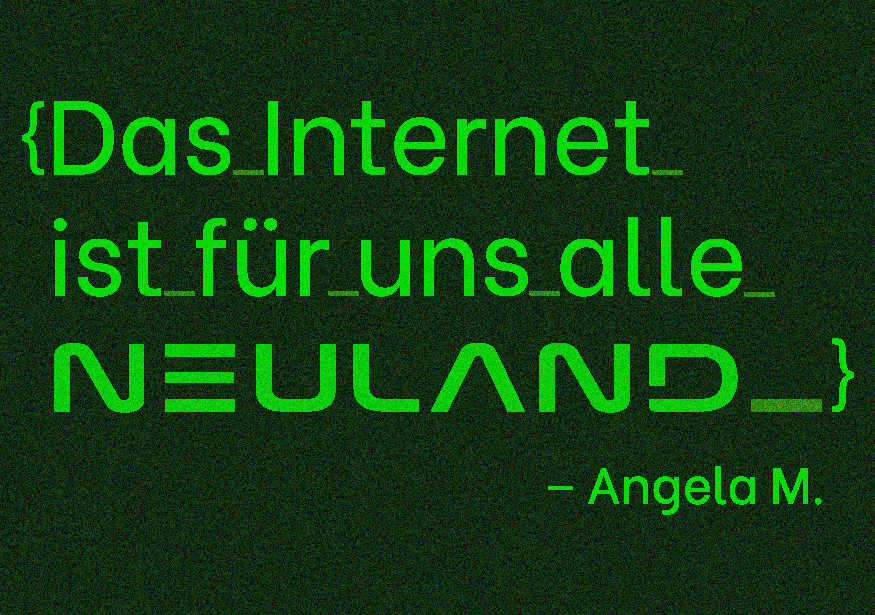Based meme - Easy
Can you help me retrieve this awsome meme?
The task description tells us that we should retrieve a meme from an email that somehow got corrupted. As the name of the challenge implies, the meme is Base64 encoded in the body of the email. Base64 is used to encode binary data like images in HTML emails into ASCII characters. The email body can be fixed in the following way:

Afterwards the email can be opened in an email program or the html part of the email can be opened in the browser. You could also use CyberChef to render the image.

The flag is nland{Das_Internet_ist_für_uns_alle_NEULAND_}.
Friend or foe - Medium
A Neuland member lost his office access card, can you duplicate the key?

According to the description it is an access card, this leads to the assumption that it is an RFID card. If we shine a light through the card, the antenna and chip can be seen. The easiest way to read the data is the NFC reader of a cell phone. This can be done using an app or by activating NFC and bringing the mobile phone into contact with the card. The mobile phone will then be able to read the data and shows the flag.

The flag is nland{1ff_m42k_2}.
PDF - Medium
I received a weird PDF from a friend.
When opening the PDF, a window with the text “You are hacked!” is displayed and the calculator of the end device opened.

If the PDF is opened in a text editor, the responsible JavaScript function can be found in line 32.
/JS (app.alert\("You are hacked!"\); app.launchURL\("START C:/\Windows/\system32/\calc.exe", true\); console.println\("bmxhbmR7ajR2NDVjMjFwNzo3aDNfOTAwZF9wNDI3NX0="\);)
At the end of the function a Base64 string is written to the console which can be converted to the flag with CyberChef FromBase64.
The flag is nland{j4v45c21p7:7h3_900d_p4275}.
Automotive Report - Medium
We have been notified of a vehicle accident! As forensic investigators, we need to take a look at the report that was generated. However, the file looks broken to me. I bet the police department we got the report from is busy streaming on Instagram or TikTok right now. Here’s where they messed up when creating the report….
The police department wants to know the unique identifier of the car. What are they talking about?
The flag format is nland{<unique-identifier>}
TL;DR
The pdf file is manipulated. Some stream and endstream keywords are missing. Add those and the pdf will work again. The flag is the VIN highlighted within the report.
Detailed version
The file command indicates that this file is a version 1.5 PDF document. We can verify this by looking for the header and the corresponding magic bytes.
$ xxd tamperd.pdf| head -n 1
00000000: 2550 4446 2d31 2e35 0a25 e2e3 cfd3 0a34 %PDF-1.5.%.....4
Based on Wikipedia, the hex signature of a PDF document is “25 50 44 46 2D”. As we can see in the output above, this is valid in our case. So the usual manipulation of magic bytes is not the case here
When you open the PDF file in a PDF viewer, you see a white screen. So the structure is messed up.
This blogpost gives us a good overview of the basic structure of PDF documents.
---------------
| |
| Header |
| |
---------------
| |
| |
| |
| Body |
| |
| |
| |
---------------
| 'xref' Table |
---------------
| Trailer |
---------------
We can see that each file contains a header, a body, an xref table and a trailer. The data resides in various objects that use specific types such as streams, dictionaries, arrays, and others. The description of the task suggests that the police department does a lot of streaming. Let’s take a closer look at the file containing these types.
We use a text editor to view the file. In my case, it’s neovim.
%PDF-1.5
%âãÏÓ
4 0 obj
<<
/Filter /FlateDecode
/Length 882
>>
xµVÛrÓ0}÷Wì£ÄL]-«oЦ3íb`à!'
ê [...]
endobj
9 0 obj
<<
/ColorSpace /DeviceRGB
/Subtype /Image
[...]
0000117325 00000 n
0000117377 00000 n
trailer
<<
/Info 19 0 R
/ID [<dc414c3458cffbbf0f200d6cc36854bf><b37a1fcea648cbf5f6e9376115e235a9>]
/Root 18 0 R
/Size 20
>>
startxref
117563
%%EOF
The above snippet shows us the PDF 1.5 header, an object (obj) including its end (endobj), the beginning of another object and the end of the PDF document which contains a reference to the beginning of the xref table (startxref) and the trailer (trailer).
Scrolling through the file, we see a pattern. We create an object (obj), have some additional information in it, and exit the object (endobj). However, some of the objects contain stream sections that are rounded off by stream and endstream. These keywords are usually arranged around these large pieces of data like
xµVÛrÓ0}÷Wì£ÄL]-«oЦ3íb`à!'
ê [...]
Let’s add the keywords stream and endstream around these chunks and check what happens. We can see two places where the chunks of data are not rounded by the keywords. If we add them and save the file, we can view the PDF document.
The task description asks for a unique identifier for a vehicle. A quick look on the Internet tells us that the so-called VIN or vehicle identification number is the unique identifier for each vehicle. In our case this is 5YJ3E1EA1JF0000. Consequently, the license plate number is nland{5YJ3E1EA1JF0000}.